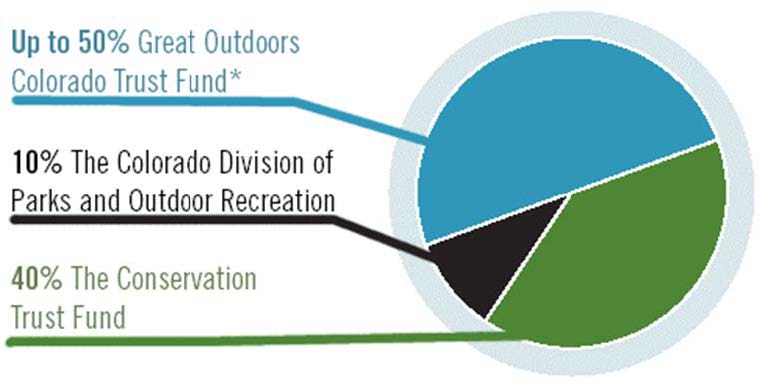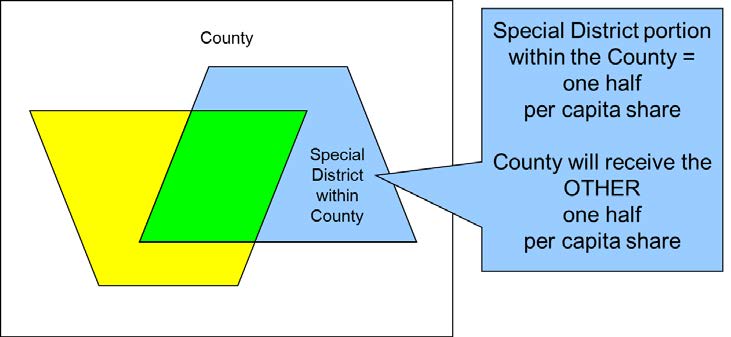CTF Frequently Asked Questions
General
Conservation Trust Funds are the portion of Lottery proceeds constitutionally mandated to be distributed directly to local governments, based on population, for acquiring and maintaining parks, open space and recreational facilities. The funds are distributed and monitored through the Colorado Department of Local Affairs (DOLA).

Eligible entities include counties, cities, towns, and Title 32 special districts that provide park and recreation services in their service plans. There are currently 64 counties, 272 municipalities, and 134 special districts participating in the CTF program.
- "Eligible entity means a county, municipality, or special district which has created a conservation trust fund pursuant to this section and which has certified to the department of local affairs that it has created such fund.” C.R.S. 29-21-101(1)(b)
- "Municipality means a statutory or home rule city or town or a territorial charter city.” C.R.S. 29-21-101(1)(d)
- "Special district means:
(I) a special district organized under article 1 of title 32, C.R.S., which provides park or recreation facilities or programs pursuant to the district's service plan, which facilities or programs are open to public use” C.R.S. 29-21-101(1)(g)
Distributions
CTF is distributed quarterly on a per capita basis. 2012 funds are distributed using 2010 final population estimates. Each local government has an opportunity to submit written challenges to these estimates. The State Demography Office (SDO) provides DRAFT population estimates to each local government in two phases:
- The 1st phase involves estimates of Total Housing Units & Group Quarter Populations (GQP) (such as college dormitories, prisons, nursing homes). These data will be used as a foundation for each entity’s population estimate.
- The 2nd phase involves estimates of Population numbers and Vacancy Rates.
The per capita share is determined as follows:
- Counties will receive a full per capita share for the population within their unincorporated boundaries that are not overlapped by a special district;
- Municipalities will receive a full per capita share for the population within their incorporated boundaries that are not overlapped by a special district; and
- Special districts will receive one-half of a per capita share. C.R.S. 29-21-101(2)(a)(II)
The following graphics detail the per capita share for counties, municipalities, and special districts.


Yes. Local governments are permitted to cooperate on joint projects with other local governments on eligible CTF properties and expenditures.
“In the utilization of moneys received pursuant to this section, each eligible entity may cooperate or contract with any other government or political subdivision, including a conservation district established in accordance with the provisions of article 70 of title 35, C.R.S., or a local noxious weed control program, pursuant to part 2 of article 1 of this title. Subject to the separate accounting requirement of subparagraph (II) of paragraph (b) of subsection (2) of this section, such cooperation may include the sharing of moneys held by any such entities in their respective conservation trust funds for joint expenditures for the acquisition, development, and maintenance of new conservation sites, as defined in paragraph (e) of subsection (1) of this section in accordance with the provisions of article XXVII of the state constitution.”
C.R.S. 29-21-101(5)
CTF distributions are strictly based on eligible local government’s population and the CTF revenues available each quarter. While a population increase for an eligible local government may equate to an increase in their distribution, the formula still depends on the CTF revenue available.
Special districts may consider incorporation to increase their per capita allocation from one-half to a full per capita allocation.
No. All participating special districts, as defined on page 1, receive the same one-half per-person allocation based on their population and the CTF revenues available each quarter.
No. All participating local governments are subject to the same formula of population and CTF revenue available, regardless of their location in the state. However, population is the key factor, so it is not unreasonable for urban areas to receive more dollars verses a rural area that has a higher population base.
Uses
CTF can be used for the acquisition, development, and maintenance of new conservation sites or for capital improvements or maintenance for recreational purposes on any public site. A public site is defined by the department as a publicly owned site, or government owned property. A more detailed list of CTF eligible activities can be found on the CTF website.
As defined in statute:
"New conservation sites means interests in land and water, acquired after establishment of a conservation trust fund pursuant to this section, for park or recreation purposes, for all types of open space, including but not limited to floodplains, greenbelts, agricultural lands, or scenic areas, or for any scientific, historic, scenic, recreational, aesthetic, or similar purpose.”
C.R.S. 29-21-101(1)(e)
"Interests in land and water means any and all rights and interests in land or water, or both, including fee interests and less than full fee interests such as future interests, developmental rights, easements, covenants, and contractual rights. Every interest in land or water may be in perpetuity or for a fixed term and shall be deemed to run with the land or water to which it pertains for the benefit of the citizens of this state.”
C.R.S. 29-21-101(1)(c)
A brief list of recreational properties (available on the CTF website) includes:
- Parks and Open Space
- Athletic fields and courts
- Community and Recreation Centers
- Swimming pools
- Libraries
- Museums
- Fairgrounds
- Campgrounds
- Golf Courses
- Zoos
- Skate parks
- Skating rinks
- Shooting ranges